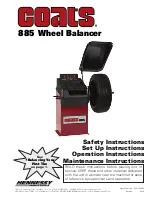
Important: Always read and follow the instructions.
• 5
Optional
Front Cone
/Collet
Mounting
A wheel should be centered by the outer side of the
hub only when the inner surface will not provide an
accurate surface to center on.
1.
Select the cone that best fits the center hole in the
wheel.
2.
Lift the wheel onto the shaft and slide it back
against the shaft faceplate.
3.
Slide the cone onto the shaft and into the center
of the wheel. You will need to lift the tire to seat the
cone in the center hole.
4.
Install the hub nut (without pressure cup) onto the
shaft. Tighten it securely against the cone. The hub nut
must engage the threads for at least
four
full turns.
Note: If the hub nut will not tighten completely
because of a lack of threads, use an additional cone as
a spacer between the mounting cone and the hub nut.
The wheel must be forced firmly against the faceplate.
Note:
Do not front cone chrome or clad wheels.
Front Cone/Collet Mounting
Cone/Collet
Shaft
Faceplate
Hub Nut with
Pressure Cup
S
pacer
Alternate Mounting
If the wheel has a protruding outer hub which will not
permit the use of the pressure cup, or the cup will not
permit the hub nut to engage at least four turns of the
shaft, this alternate method should be used.
1.
Place the cone spring onto the balancer shaft with
the large end towards the faceplate.
2.
Select the cone/collet that best fits the center hole
in the wheel. Slide the cone/collet onto the shaft with
the large end towards the faceplate.
3.
Lift wheel onto the shaft and center it on the cone/
collet.
4.
Use the small nylon spacer (no-mar ring) or a cen-
tering cone/collet to press against the outer wheel hub.
5.
Install the hub nut (without the pressure cup) onto
the shaft. Tighten securely.
Alternate Mounting
Built in
Spring
of Faceplate
Shaft
No-Mar
Ring
Faceplate
Cone/Collet
Hub Nut with
Pressure Cup



























